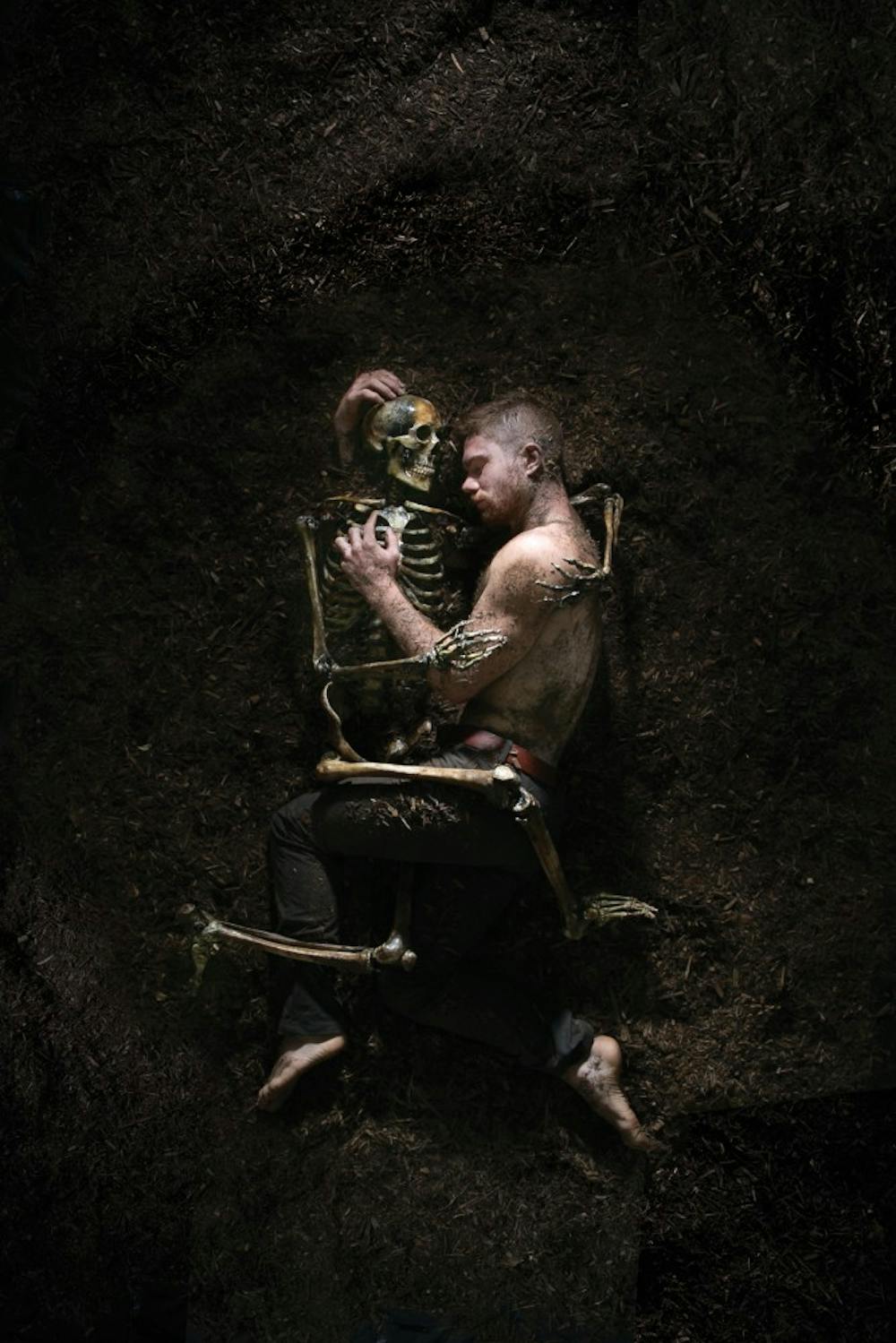Gunnar Montana’s Purgatory, part of Philadelphia’s 2015 Fringe Festival, greets its audience with a smile and a handshake. For anyone who grew up in the Church, or with even a peripheral connection to a priest, pastor or congregation, the feeling is familiar: Church is beginning. The set is no typical cathedral, however. A large, ominous hook dangles from the ceiling in the middle of the room. Golden skeletons hang despondently on crosses. Gothic baptismal wells divide audience seating on two sides, next to chairs with signs reading, “Guests seated here may get a little baptized.” It is evident the service will be no comfort to the soul.
 Montana has made a name for himself in the Philadelphia theater scene for creating shows that manage to be seriously disturbing, clever and moving, all at once. His most impressive work to date, Purgatory unfolds as a cluster of vignettes, conveyed through choreography and backed by a well–curated soundtrack. Each routine takes up a familiar religious symbol, but with a queer or melancholic twist. One number, choreographed to Hozier’s “Take Me to Church,” takes the form of an erotic baptismal feud between Montana and dancer Adrian Plascencia. The duet thrives on the ambiguity of their intentions: whether they’re trying to make love, save each other’s souls or drown a hated rival is left to the imagination. In another scene, local drag celebrity Iris Spectre (Dylan Kepp) plays a Pope who delights privately in a pair of shiny red heels. The piece builds toward histrionic ecstasy as Barbra Streissand’s “Don’t Rain on My Parade” blares from the speakers.
Montana has made a name for himself in the Philadelphia theater scene for creating shows that manage to be seriously disturbing, clever and moving, all at once. His most impressive work to date, Purgatory unfolds as a cluster of vignettes, conveyed through choreography and backed by a well–curated soundtrack. Each routine takes up a familiar religious symbol, but with a queer or melancholic twist. One number, choreographed to Hozier’s “Take Me to Church,” takes the form of an erotic baptismal feud between Montana and dancer Adrian Plascencia. The duet thrives on the ambiguity of their intentions: whether they’re trying to make love, save each other’s souls or drown a hated rival is left to the imagination. In another scene, local drag celebrity Iris Spectre (Dylan Kepp) plays a Pope who delights privately in a pair of shiny red heels. The piece builds toward histrionic ecstasy as Barbra Streissand’s “Don’t Rain on My Parade” blares from the speakers.
Plainly enough, a spirited iconoclasm pervades Montana’s latest work. Purgatory’s twisted, sexy spin on the world of the afterlife leaves little question as to Montana’s take on religion: in short, he’s skeptical. Still, it would be a mistake to say Montana appears very interested in sacrilege or heresy. The liminal space Purgatory envisions is rife with deviance, perversely funny and wretchedly lonely, but it is not without faith. Whatever this faith may be said to consist of, it thrives on a perseverance of passion—passion in movement and for the art of connecting: sometimes with other drifting souls, sometimes with a buried part of oneself, at other times with a pair of shimmering red heels.
We should acknowledge what’s edgy and timely about Montana’s show, of course. With Philadelphia’s momentous 2015 papal visit less than a month away, Purgatory’s queer take on an aesthetics of damnation nicely answers the sting of an event titled the “World Meeting of Families,” which takes for granted the exclusion of LGBT families. Rather than taking the Church’s “No” for an answer, Montana takes its symbols as his own, insisting that they belong as much to a deviant periphery as to the charmed circle of the saved.
But the genius of Purgatory lies still elsewhere. Purgatory is not iconoclasm pure and simple. Rather, it transpires as a disturbed revelry in iconography, as if an alien mind has taken our most sacred symbols for his playthings. And yet, play is not quite the word for it either, since Purgatory consistently gets at something genuine and meaningful about the morbid consciousness fostered by alienation.
Considering Montana’s ongoing interest in drag performance (his 2014 Resurrection Room took place in a hot pink, labyrinthine extraterrestrial dragscape), we might be better off describing Purgatory as a sophisticated take on camp. Generally understood as a queer style of parody, camp is excessive with its subject matter, often designed to shock an audience, yet with a semblance of utter nonchalance, as though oblivious to its own transgressions. As some have noted, however, camp’s excess also has a long history of being a queer strategy for survival—a way of working through impasses deeply, intractably real. Montana seems to suggest that camp may be one of our best available variations on faith: a style underpinned by doubt, even irony, yet which takes doubt as an invitation to dust off old icons and make them new.
Photo: Neal Santos







